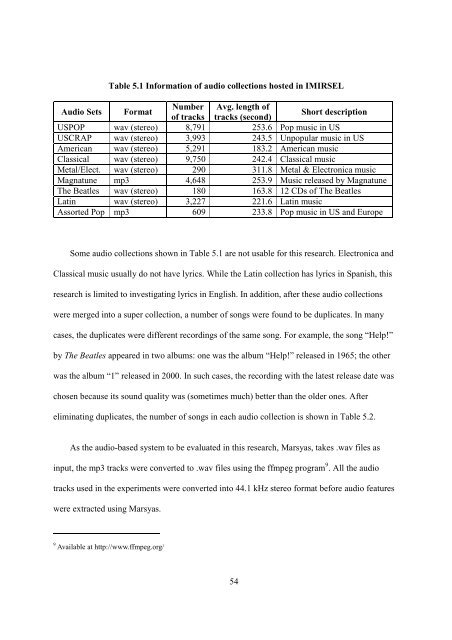improving music mood classification using lyrics, audio and social tags
improving music mood classification using lyrics, audio and social tags
improving music mood classification using lyrics, audio and social tags
You also want an ePaper? Increase the reach of your titles
YUMPU automatically turns print PDFs into web optimized ePapers that Google loves.
Table 5.1 Information of <strong>audio</strong> collections hosted in IMIRSEL<br />
Audio Sets Format<br />
Number Avg. length of<br />
of tracks tracks (second)<br />
Short description<br />
USPOP wav (stereo) 8,791 253.6 Pop <strong>music</strong> in US<br />
USCRAP wav (stereo) 3,993 243.5 Unpopular <strong>music</strong> in US<br />
American wav (stereo) 5,291 183.2 American <strong>music</strong><br />
Classical wav (stereo) 9,750 242.4 Classical <strong>music</strong><br />
Metal/Elect. wav (stereo) 290 311.8 Metal & Electronica <strong>music</strong><br />
Magnatune mp3 4,648 253.9 Music released by Magnatune<br />
The Beatles wav (stereo) 180 163.8 12 CDs of The Beatles<br />
Latin wav (stereo) 3,227 221.6 Latin <strong>music</strong><br />
Assorted Pop mp3 609 233.8 Pop <strong>music</strong> in US <strong>and</strong> Europe<br />
Some <strong>audio</strong> collections shown in Table 5.1 are not usable for this research. Electronica <strong>and</strong><br />
Classical <strong>music</strong> usually do not have <strong>lyrics</strong>. While the Latin collection has <strong>lyrics</strong> in Spanish, this<br />
research is limited to investigating <strong>lyrics</strong> in English. In addition, after these <strong>audio</strong> collections<br />
were merged into a super collection, a number of songs were found to be duplicates. In many<br />
cases, the duplicates were different recordings of the same song. For example, the song “Help!”<br />
by The Beatles appeared in two albums: one was the album “Help!” released in 1965; the other<br />
was the album “1” released in 2000. In such cases, the recording with the latest release date was<br />
chosen because its sound quality was (sometimes much) better than the older ones. After<br />
eliminating duplicates, the number of songs in each <strong>audio</strong> collection is shown in Table 5.2.<br />
As the <strong>audio</strong>-based system to be evaluated in this research, Marsyas, takes .wav files as<br />
input, the mp3 tracks were converted to .wav files <strong>using</strong> the ffmpeg program 9 . All the <strong>audio</strong><br />
tracks used in the experiments were converted into 44.1 kHz stereo format before <strong>audio</strong> features<br />
were extracted <strong>using</strong> Marsyas.<br />
9 Available at http://www.ffmpeg.org/<br />
54
















